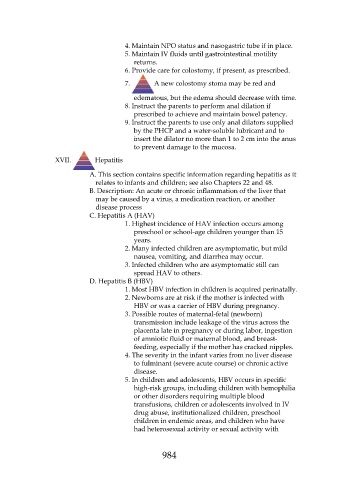Page 984 - Saunders Comprehensive Review For NCLEX-RN
P. 984
4. Maintain NPO status and nasogastric tube if in place.
5. Maintain IV fluids until gastrointestinal motility
returns.
6. Provide care for colostomy, if present, as prescribed.
7. A new colostomy stoma may be red and
edematous, but the edema should decrease with time.
8. Instruct the parents to perform anal dilation if
prescribed to achieve and maintain bowel patency.
9. Instruct the parents to use only anal dilators supplied
by the PHCP and a water-soluble lubricant and to
insert the dilator no more than 1 to 2 cm into the anus
to prevent damage to the mucosa.
XVII. Hepatitis
A. This section contains specific information regarding hepatitis as it
relates to infants and children; see also Chapters 22 and 48.
B. Description: An acute or chronic inflammation of the liver that
may be caused by a virus, a medication reaction, or another
disease process
C. Hepatitis A (HAV)
1. Highest incidence of HAV infection occurs among
preschool or school-age children younger than 15
years.
2. Many infected children are asymptomatic, but mild
nausea, vomiting, and diarrhea may occur.
3. Infected children who are asymptomatic still can
spread HAV to others.
D. Hepatitis B (HBV)
1. Most HBV infection in children is acquired perinatally.
2. Newborns are at risk if the mother is infected with
HBV or was a carrier of HBV during pregnancy.
3. Possible routes of maternal-fetal (newborn)
transmission include leakage of the virus across the
placenta late in pregnancy or during labor, ingestion
of amniotic fluid or maternal blood, and breast-
feeding, especially if the mother has cracked nipples.
4. The severity in the infant varies from no liver disease
to fulminant (severe acute course) or chronic active
disease.
5. In children and adolescents, HBV occurs in specific
high-risk groups, including children with hemophilia
or other disorders requiring multiple blood
transfusions, children or adolescents involved in IV
drug abuse, institutionalized children, preschool
children in endemic areas, and children who have
had heterosexual activity or sexual activity with
984

